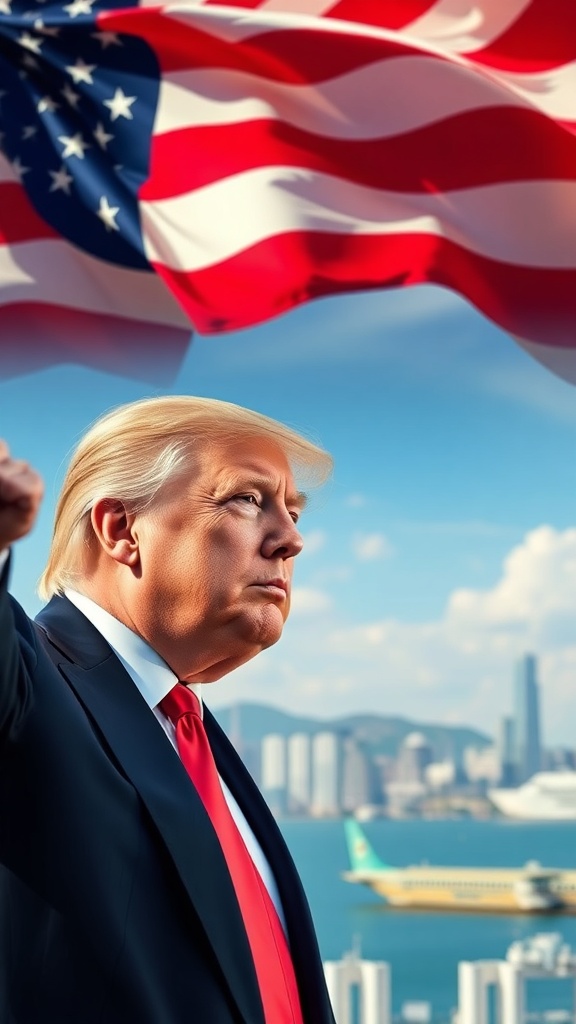Trump’s Influence on American Tourism: A New Era for International Travelers
Understanding the impact of a president on national identity is crucial, especially when it comes to tourism. Since taking office, Trump’s influence has undeniably shifted the landscape of American tourism. This shift encompasses everything from international perceptions to policy changes that travelers face.
Thank you for reading this post, don't forget to subscribe!During Trump’s presidency, public sentiment surrounding travel to America was mixed. Supporters touted an increase in domestic tourism, thanks to a focus on national pride and patriotism. However, the administration’s tough stance on immigration and travel restrictions also made many international travelers reconsider their plans to visit the United States.
Policy Changes and their Effects
One significant change under Trump was the tightening of visa policies. New rules and regulations made it harder for specific demographics to obtain travel visas. The backlash from these policies impacted how foreigners perceived America. Travelers from countries affected by these restrictions often felt unwelcome.
- Difficulty in obtaining travel visas for certain nationalities.
- Increased scrutiny for international visitors, affecting their arrival experiences.
- Heightened security measures at airports, resulting in longer wait times.
The new policies added a layer of complexity to international travel, making America seem less approachable. As a result, potential visitors started looking to alternative destinations for their vacations, causing a dip in tourism numbers.
Economic Impact on Tourism
The economic implications were significant. With fewer international travelers coming to the U.S., the tourism sector felt the pinch. Hotels, airlines, and local businesses that relied on tourists saw a decline in revenue. For many, this meant layoffs and reduced hours, which further harmed local economies dependent on tourism.
According to reports, major tourist cities like New York and San Francisco experienced noticeable drops in international visitor numbers during Trump’s presidency. Other regions that heavily rely on tourism felt similar effects, with some experiencing a more profound economic downturn than others.
The Role of the New $250 Visa Fee
Compounding these issues is the introduction of a new $250 visa fee for travelers from various countries. This fee was announced as a way to streamline the visa processing system. However, it raises questions about accessibility. For some travelers, an additional cost could deter them from choosing the U.S. as their vacation destination.
This new fee is expected to add to the existing barriers that international travelers face. When combined with the stricter visa regulations seen during Trump’s term, it becomes clear that accessing the United States is becoming increasingly complex.
The Shift in Global Perspective
The international community’s view of America is undoubtedly changing. For some, the country remains a symbol of opportunity and adventure. Yet, the administration’s policies have altered perceptions, especially among those who value freedom of movement and inclusivity.
Social media plays an essential role in shaping public opinion, with travelers sharing their experiences online. Positive reviews can bring a surge of visitors, while negative experiences spread like wildfire. A blossoming sense of community on platforms like Instagram and Twitter can influence decisions on where to travel next.
Experiences Matter
For those thinking of visiting the U.S., the experience remains vital. Travelers are looking for destinations that offer safety, change, and adventure. While Trump’s influence has created hurdles for international tourism, it has also ignited a need for American cities to rebrand themselves as welcoming and inclusive spaces.
In response to these challenges, many regions are increasingly investing in marketing that emphasizes hospitality and openness. Tourist boards are running campaigns aimed at making travelers feel wanted and celebrated rather than scrutinized and judged.
As the dynamics of American tourism evolve, one thing is certain: the impact of political policy extends far beyond borders. Understanding these changes can help prepare international travelers for their journey while highlighting the resilience of the tourism industry in the face of adversity.
In sum, the interplay between Trump’s policy changes and the newly introduced visa fee marks a critical moment for international travelers. Understanding the barriers they face and finding ways to navigate them can make a significant difference in one’s travel experience. Ultimately, fostering a more welcoming atmosphere could serve to revive American tourism and bring back the influx of visitors that once defined its landscape.
The Impact of the New $250 Visa Fee on Travel Decisions and American Tourism
The recent announcement of a new $250 visa fee has created a ripple effect in the travel industry, raising concerns and questions among potential tourists. For many international travelers, this fee could influence their decision to visit the United States, an essential part of American tourism. The impact of this new fee extends beyond individual choices; it could significantly reshape the landscape of travel to the U.S.
Travelers often weigh numerous factors when planning a trip. Costs are a major consideration. A $250 visa fee is substantial compared to previous fees and can deter many from planning their journey. Whether you are from Europe, Asia, or Latin America, this increased fee can reshape your budget and plans.
Here are some of the reasons the new $250 visa fee may influence travel decisions:
- Budget Constraints: Many travelers stick to strict budgets. The additional fee might push some to reconsider or even cancel trips.
- Alternative Destinations: With rising travel costs, some may choose to explore other countries where the fees are lower, thus affecting American tourism.
- Spending Reductions: If travelers do decide to come to the U.S., they might reduce other spending to accommodate the new fee.
In contrast, some prospective travelers may still prioritize visiting the U.S. for its unique attractions, vibrant culture, and diverse experiences. For individuals yearning for an American adventure, the fee may feel like just one more part of the journey rather than a barrier. These travelers might still be willing to pay the additional charge, understanding that visiting iconic destinations like New York City, the Grand Canyon, or Walt Disney World is worth the investment.
However, potential visitors are also likely to seek information about the visa process. Many travelers want to know what the fee covers and how it impacts their travel experience. This search for clarity highlights the importance of transparent communication from both the U.S. government and travel agencies.
As the tourism industry evaluates how this new fee will affect travel trends, businesses must adapt. Here are some strategies that could help the industry mitigate the effect of the $250 visa fee:
- Value-Added Services: Businesses could offer travel packages that include unique experiences or discounts to offset the cost of the visa fee.
- Enhanced Promotion: Highlighting promotional campaigns, exploring new destinations, or offering special deals can capture interest and drive bookings.
- Information Campaigns: Providing clear, concise information about the visa process can help alleviate traveler uncertainties and encourage them to proceed with their plans.
The timing of the new visa fee introduction is crucial. Many travel companies saw an uptick in bookings after COVID-19 restrictions were lifted. However, the new fee could slow this positive trend. It’s essential for businesses and tourism boards to keep a finger on the pulse of traveler sentiment as they navigate this changing landscape.
This fee, introduced at a sensitive time, requires careful handling to ensure that tourism in the U.S. does not take a hit. This is especially important for regions that heavily rely on international visitors, such as Florida or California. Local economies thrive on the money that tourists bring in, and a dramatic drop in tourism could have a cascading effect. Hotels, restaurants, and countless small businesses depend on international travelers’ dollars to survive.
In addition, the new visa fee could also impact Americans traveling abroad. If international travel becomes less appealing due to reciprocal costs, U.S. citizens may find their opportunities limited. This will lead to fewer cultural exchanges, diminishing the global interconnectedness that travel promotes. The U.S. is known for its welcoming nature, and barriers to entry can feel counterintuitive to that ethos.
The introduction of the new $250 visa fee has sparked concerns about its impact on travel decisions to the United States and the broader landscape of American tourism. As travelers reassess their plans, the industry must adapt and find ways to offer compelling reasons to visit despite the additional costs involved. By doing so, they can maintain the vibrancy of American tourism in the face of these new challenges.
Conclusion
As we analyze Trump’s influence on American tourism, it’s clear that his presidency initiated a new era for international travelers. The shift in policies, whether through increased restrictions or enhanced protections, shaped traveler perceptions and decisions about visiting the U.S. Factors such as changing visa regulations, political rhetoric, and global events connected to Trump’s administration played significant roles in defining how tourists viewed America as a destination.
The introduction of the new $250 visa fee adds another layer of complexity to these travelers’ experiences. With travel costs on the rise, this fee might deter some potential visitors while encouraging others to explore the cultural and economic offerings of the United States. Ultimately, every vacation choice involves cost-benefit analysis; for many, the allure of American landmarks might outweigh the added financial burden of obtaining a visa.
As these dynamics continue to evolve, American tourism faces a crossroads. Understanding the interplay between political climate, economic factors, and traveler sentiments is crucial for the tourism industry. The combined effects of Trump’s policies and the new visa fee underscore the necessity for a responsive and adaptable strategy to ensure that the U.S. remains a desirable destination. By fostering positive relationships with international communities and making travel more accessible, America can revitalize its tourism sector and welcome travelers from all over the globe. Engaging these visitors not only enriches the cultural fabric of the nation but also drives vital economic growth.






